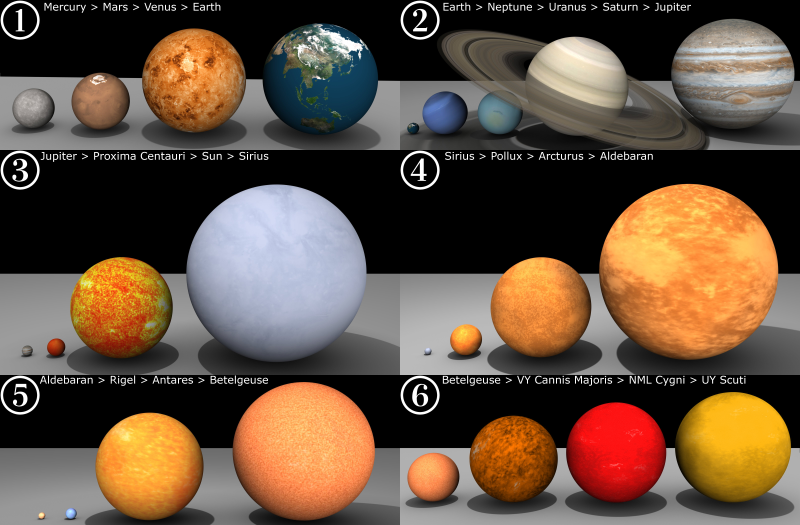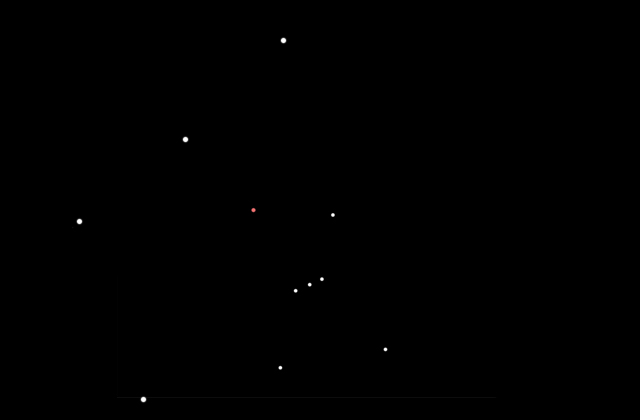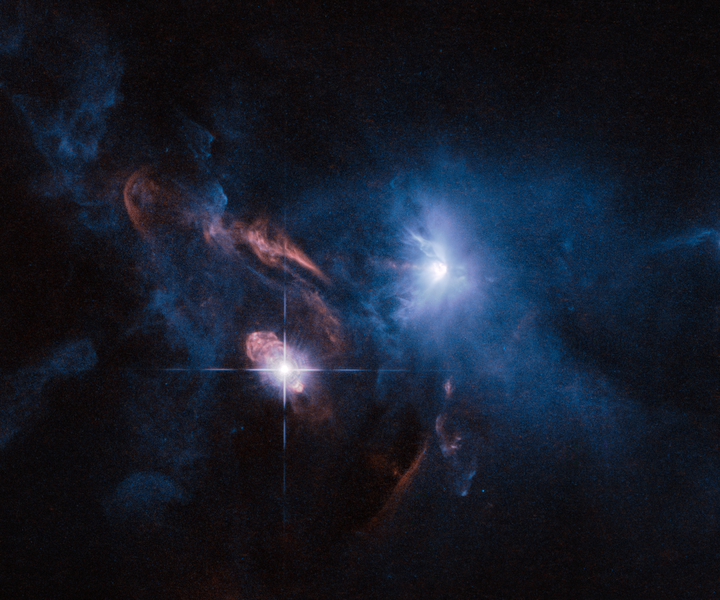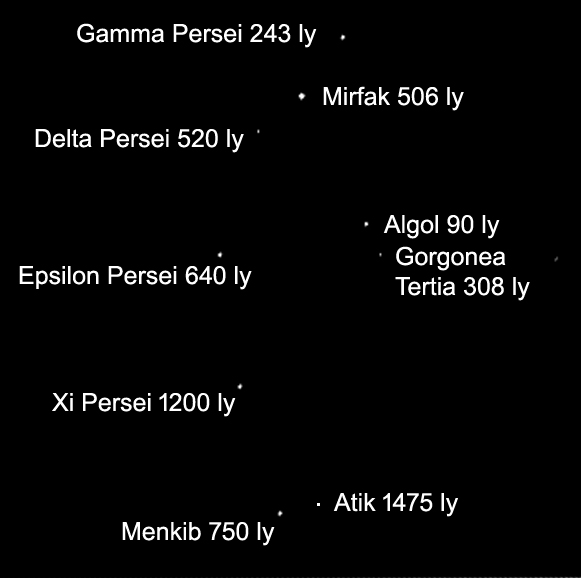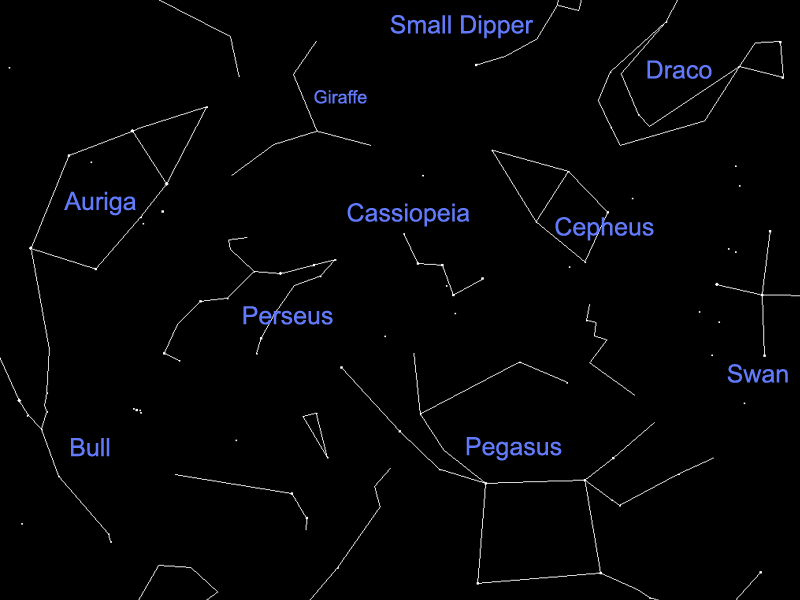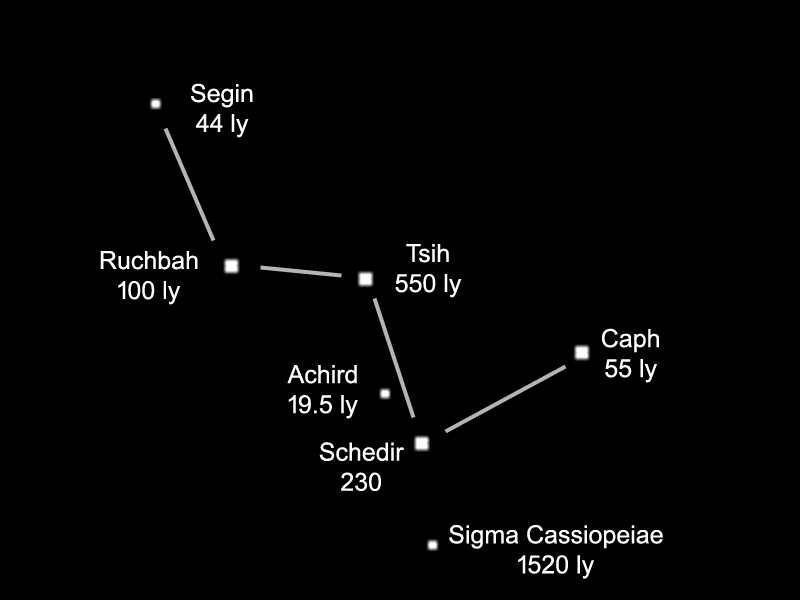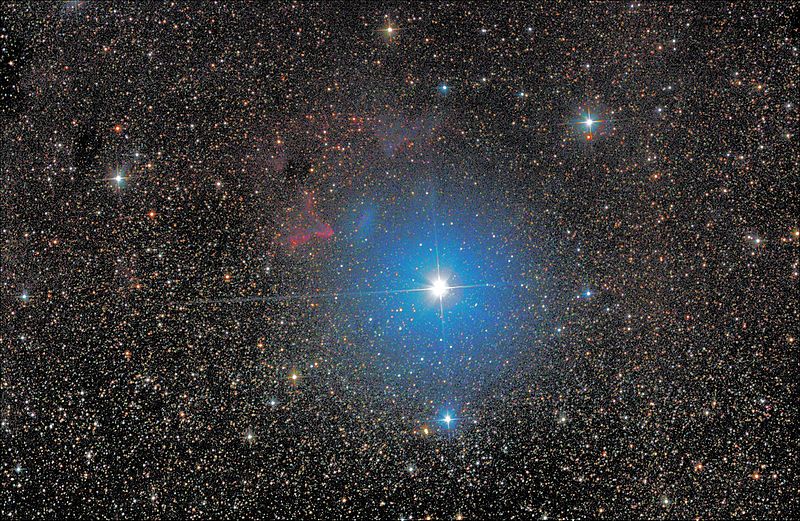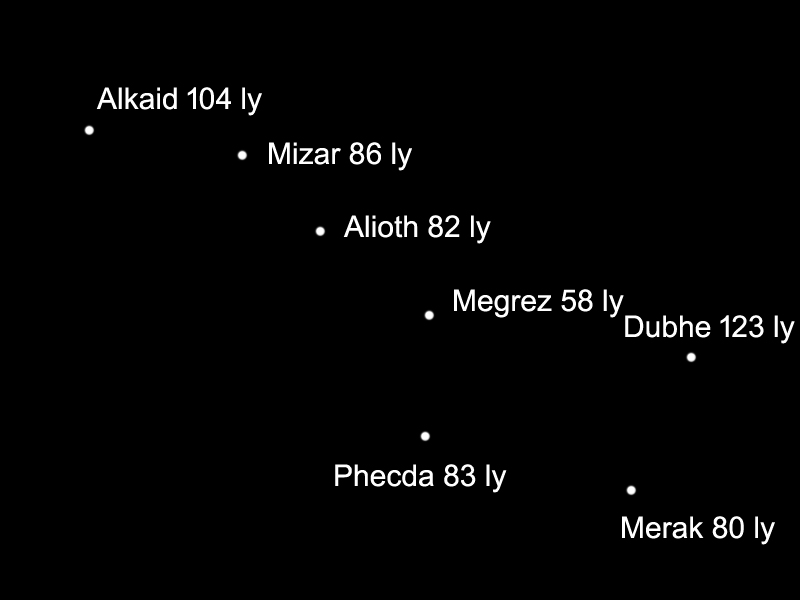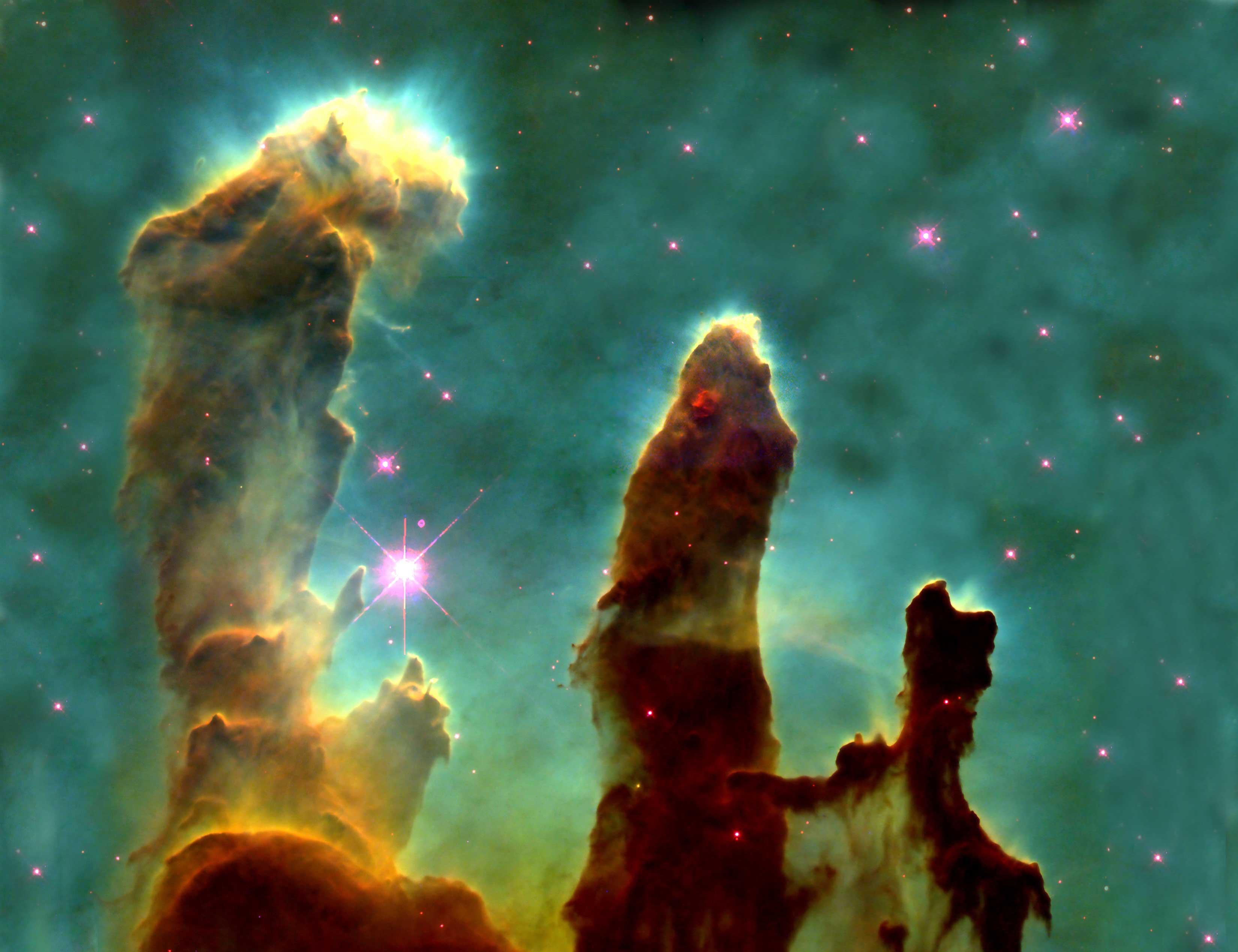Learn the names of the stars in the night sky. Starnames. Finding , knowing or naming the stars in the sky.
How can I learn the names of the stars in the night sky. In this article we will learn many names of the stars in the night sky. And we will see what the special things are to know about the stars so you will also have a guide to what are the interesting stars. You will learn a lot of the star names here but it is not for one day so set a bookmark now if you like. We will learn here the names of the stars in the northern hemisphere. So we will also see many stars that can be seen in the southern hemisphere but it will actuall look at the northern hemisphere stars. Since Earth turns around itself but never turns upside down in the northern hemisphere we see the star above earth and in the southern hemisphere we see the stars below earth. So on the northern half of the earth people see different stars then on the southern side. Or lets better say some stars are never seen on both sides, many stars can be seen on both sides because earth is not standing straight up but is tilted a bit to the side compared to the rotational plane around the sun and rotates around this tilted angle and so on the upside and the downside you can see lower and upper stars during the course of a year. If you want to learn names of the stars you are at the right place here. I started lately to learn naming the stars in the night sky. So here is an article about the names of the stars in the sky. Finding the stars in the night sky and naming and finding the constellations is not really difficult. We will easily learn the constellations here and we will see the names of the stars. All in this article. What are the names of the stars.This article contains skymaps of course but if you want to have a complete skymap look here. Good Skymap. First enter the nearest city to where you are. This is a fantastic skymap, just what you need. Take your time to understand it, it is not complicated, this is by far the best online star map I have ever seen. Any time you see stars in the sky that should not be there you are probably seeing a planet like Venus or Jupiter. Check the skymap where you can switch the planets on and off. The planets look like very bright stars but they change position over the weeks. So if you want to learn star positions you should check where the planets are at the moment because they look like stars but are actually planets. Every constellation has many hundred stars, but you do not see them in the sky. Science has discoverd very many stars that can not be seen with the naked eye. Of course we do not want to learn the names of these stars we only look at the stars visible to the unaided eye. together with this article you can check Wikipedia for the names of the stars and also the constellations. To get more information.
We start with the winter stars, if it is in the middle of summer at the moment scroll all the way down to the summer stars.
Learning star names in winter on the northern hemispere
You will see different stars in winter then in the summer, because earth is moving. So we start with the winter stars. If you are on the southern hemisphere those are the summer stars I guess. Actually I do not really know. You will see different stars in winter then in the summer, because earth is moving. So we start with the winter stars.
The name of the stars in Orion
We start with Orion. Orion is a constellation that looked like a person to the people of old ages. Orion is very easy to find in the winter night sky. But first we have to understand that the stars in the sky are moving, they travel across the sky during the night. So in winter Orion starts in the south west and ends in the south east. So we can say that if you look to the south you should find Orion. If Orion is not in the south look from there to the left or to the right. If you just came from a lighter room you will not see all the stars of Orion. First you will see the brightest stars until your eyes have adapted and this will look something like this:  I call this the washing powder spoon, while in reality this is Orion. If you look longer onto this constellation then in this group of stars some more stars will appear and you will then see Orion completely.
I call this the washing powder spoon, while in reality this is Orion. If you look longer onto this constellation then in this group of stars some more stars will appear and you will then see Orion completely.  This now is the constellation Orion. So with this knowledge now try to find Orion, And you will see that this is really easy to know in the winter night sky. This is our first firm constellation from where we will go to the neighbouring constellations to learn the names of the stars. Old peoples saw the form of a man in this group of stars, but I believe that they saw more stars because of less light pollution to see a man in this image so this is not really to see for us today, but we note that the man was called Orion by the greeks and that the three stars in the middle are Orion’s Belt. Meaning actually the belt of this man Orion.
This now is the constellation Orion. So with this knowledge now try to find Orion, And you will see that this is really easy to know in the winter night sky. This is our first firm constellation from where we will go to the neighbouring constellations to learn the names of the stars. Old peoples saw the form of a man in this group of stars, but I believe that they saw more stars because of less light pollution to see a man in this image so this is not really to see for us today, but we note that the man was called Orion by the greeks and that the three stars in the middle are Orion’s Belt. Meaning actually the belt of this man Orion. 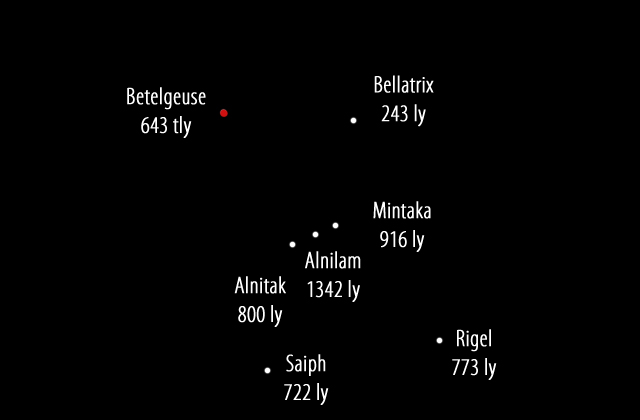 With this image you can learn your first names of the stars. Most interesting is of course the distance of the stars. How far each star is away from us. This distance is also written in the image. For example Alnitak is 800 ly away. ly means light year. And one light year is the distance that you get if you let light travel through space and then wait one year, and how far it has traveled then this is the length that we call one light year. Light is fast and if it travels one whole year then this is a big distance. From our sun to us light travels 8 minutes. From the moon to us light travels 8 seconds. So Alnitak is 800 light years (ly) away. I learn the names of the stars always together with distance to get a three dimensional image. So always learn name and distance.
With this image you can learn your first names of the stars. Most interesting is of course the distance of the stars. How far each star is away from us. This distance is also written in the image. For example Alnitak is 800 ly away. ly means light year. And one light year is the distance that you get if you let light travel through space and then wait one year, and how far it has traveled then this is the length that we call one light year. Light is fast and if it travels one whole year then this is a big distance. From our sun to us light travels 8 minutes. From the moon to us light travels 8 seconds. So Alnitak is 800 light years (ly) away. I learn the names of the stars always together with distance to get a three dimensional image. So always learn name and distance.
So before we look at what kind of stars we see here lets look at the size of stars in general:
Stars have different colors. There are yellow stars like our sun. There are white stars. and there are blue stars and red stars. Lets forget about the white ones for now and remember: Yellow, red, blue. And when I say blue I mean all kinds of light blue. And when I say red I also mean red, orange and light red. So stars are yellow or reddish or bluish.
Let us now look at the size of stars in general. Look at this below image. In part one there are some planets. of which Earth is the biggest. In Part two then Earth, the biggest planet of part one is put very small to the left and then follow bigger planets. The biggest planet at the right side of part two is then in part three the smalles object to the left again. And so it goes on. The biggest object to the right is always the smallest object under the next number. Understand how this image works and then i will explain the sun sizes.
Now we are looking at the stars or “suns” and I want to point out 3 types of suns: Small suns, giant suns and supergiant suns. First the small suns: Our Sun and Sirius in part 3. Cosmically those two stars are of about the same size. So you memorize: Sirius and Sun are two small stars of about the same size. Sirius is blue and the sun is yellow but they are of the same size.
The next bigger suns are called giants, in this case we have two “red giants” and one “blue giant“. They are called giants because they are gigantic compared to the sun. Arcturus and Aldebaran and Rigel are three suns of about the same size. you find the first two under part 4 of the above image. Compare their sizes to Sirius on the left side in part 4. Remember Sirius is about the size of the sun. You memorize: Arcturus, Aldebaran and Rigel are three stars of about the same size. The first two are red and the last one, Rigel is blue but the size of the three Arcturus, Aldebaran and Rigel is about the same.
The last stars now are the supergiants. Antares and Betelguese are such supergiants. You find them in the above image under part 5. Now compare Aldeberan and Rigel in part 5 to Antares and Betelgeuse. Memorize: Antares and Betelgeuse are among the biggest stars that we know. They are unbelievably gigantic. They are called “supergiants”
So what do we see here in the sky We look at a group of giant blue suns. All but Betelgeuse. Betelgeuse or Beteigeuze is a supergiant red sun.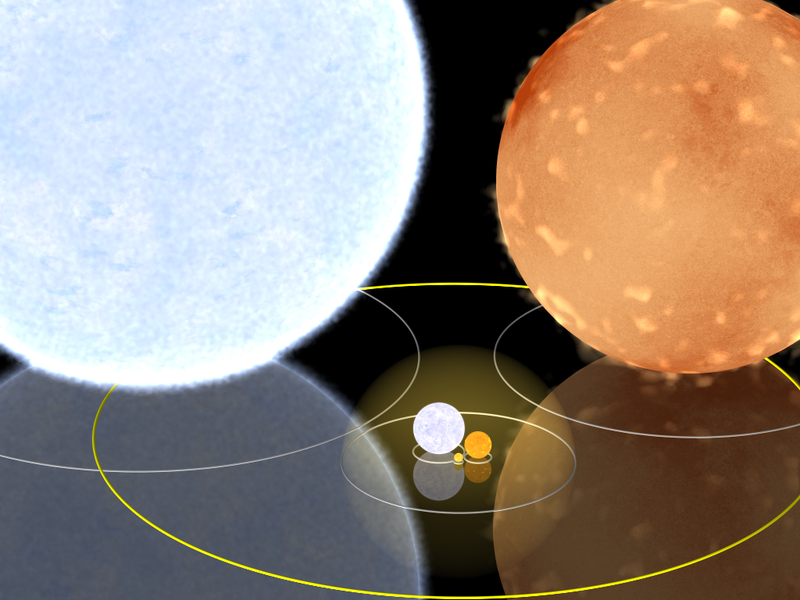 Image by Paul Stansifer and 84User.
Image by Paul Stansifer and 84User.
On this image we see our sun in the middle. The very small yellow one this is our Sun. And then we have the two giants. The giant blue star to the top left. This is the star Rigel. Then the big red sphere to the right is the star Aldebaran. And then in the middle the 3 small stars are Bellatrix, the small blue one, Algol B, the small orange one and our sun in the middle. So you see that stars have different sizes. Most of the blue stars of Orion are about the size of this big blue Rigel in the image. Compared to our sun you see that in Orion we are looking at a group of these gigantic blue suns. Very cool. This group of stars consists of much more stars then the ones that you can see. So the stars of Orion are only the biggest stars in this group of stars, that are so big, that we can see them. The same is true about the constellation Cassiopeia. Cassiopea is also a large group of giant blue suns of which we see only the brightest ones. 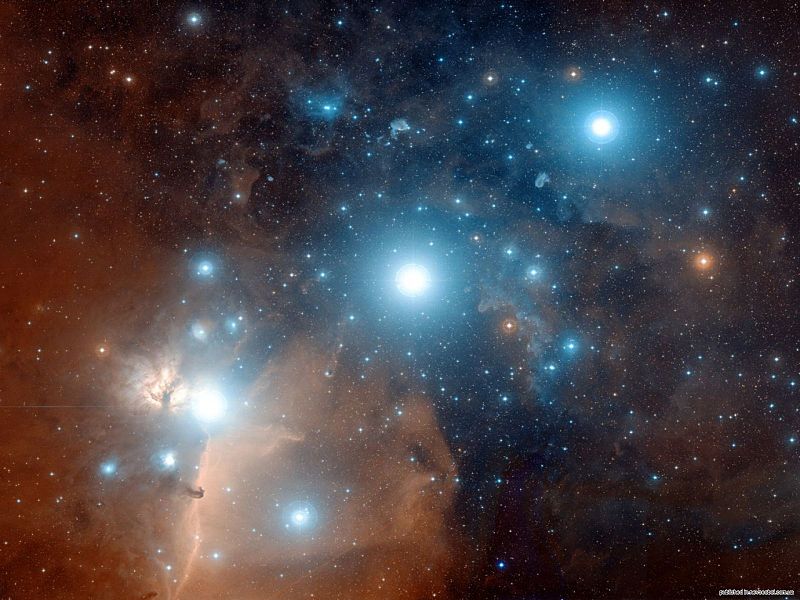 So on a Nasa Image this looks like this. You see many blue giant suns and the three in the middle that form a line are the middle of Orion, Orion’s Belt. Alnitak, Alnilam and Mintaka. Note that Alnilam in the middle is much further away then the two Alnitak and Mintaka, compare the image above, the names of the stars in Orion. And also note that Bellatrix is quite small compared to the rest, look at the size comparison image and remember, the small blue one close to our sun is Bellatrix. So bellatrix is much closer to earth then the other stars of Orion. And the stars that you see in Orion are Rigel-sized. And by that I mean the stars we named in the image, all but Betelgeuse, Betelgeuse is red and bigger, much bigger. We will look at that in a second. Of course many of the stars closely around Orion are also part of the constellation Orion, but we only look at the main stars of Orion. So Bellatrix and Betelgeuze are not Rigel sized as the rest. Bellatrix is much smaller and you see with 243 ly it is also much closer then the rest and Betelgeuse is much bigger then Rigel. Betelgeuse is a very interesting star to watch because Betelgeuse is among the biggest stars that we know. Beteigeuze is a red supergiant sun, and it is considerably bigger then Rigel.
So on a Nasa Image this looks like this. You see many blue giant suns and the three in the middle that form a line are the middle of Orion, Orion’s Belt. Alnitak, Alnilam and Mintaka. Note that Alnilam in the middle is much further away then the two Alnitak and Mintaka, compare the image above, the names of the stars in Orion. And also note that Bellatrix is quite small compared to the rest, look at the size comparison image and remember, the small blue one close to our sun is Bellatrix. So bellatrix is much closer to earth then the other stars of Orion. And the stars that you see in Orion are Rigel-sized. And by that I mean the stars we named in the image, all but Betelgeuse, Betelgeuse is red and bigger, much bigger. We will look at that in a second. Of course many of the stars closely around Orion are also part of the constellation Orion, but we only look at the main stars of Orion. So Bellatrix and Betelgeuze are not Rigel sized as the rest. Bellatrix is much smaller and you see with 243 ly it is also much closer then the rest and Betelgeuse is much bigger then Rigel. Betelgeuse is a very interesting star to watch because Betelgeuse is among the biggest stars that we know. Beteigeuze is a red supergiant sun, and it is considerably bigger then Rigel.  Image by Paul Stansifer and 84User This is the same image then before but we have zoomed out. So the small spheres in the middle are now Rigel and Aldebaran and there is still our sun between them. Our sun is the thing in the middle of the circles with the size about one pixel. It is just the comparison image above but the other two small stars, Bellatrix and Algol B are now not on the image anymore. And the small bluish star to the left is this giant Rigel and the small reddish star is again the giant Aldebaran. And now the biggest circle that you can see, the lightbrown thing that nearly fills the complete image. That is Betelgeuze. So you see that Betelgeuse is really a giant. It is about one third of the size of one of the biggest star that we know: VY canis majoris, which is to far away to be seen with the naked eye. So if you want to find a real giant star in the night sky look at the red sun Betelgeuse. The rings around our sun in the image are the orbits of our planets by the way. The red sphere around the 3 small spheres is another sun called R Doradus.
Image by Paul Stansifer and 84User This is the same image then before but we have zoomed out. So the small spheres in the middle are now Rigel and Aldebaran and there is still our sun between them. Our sun is the thing in the middle of the circles with the size about one pixel. It is just the comparison image above but the other two small stars, Bellatrix and Algol B are now not on the image anymore. And the small bluish star to the left is this giant Rigel and the small reddish star is again the giant Aldebaran. And now the biggest circle that you can see, the lightbrown thing that nearly fills the complete image. That is Betelgeuze. So you see that Betelgeuse is really a giant. It is about one third of the size of one of the biggest star that we know: VY canis majoris, which is to far away to be seen with the naked eye. So if you want to find a real giant star in the night sky look at the red sun Betelgeuse. The rings around our sun in the image are the orbits of our planets by the way. The red sphere around the 3 small spheres is another sun called R Doradus.
Some the red Betelgeuse is really a spectecular sight in the night sky.
Learn the names of the stars in the sky. The Procyon, Alhena, Elnath line
Now we look at the next stars.
So if you look away from Orion to the side of Betelgeuse you will see a very distinct row of three very light stars. This is a good thing for orientation. These Stars are from tree different constellations. Left one Canis minoris. Middle one is a star from Gemini and the right one is from Capella the wagon driver.
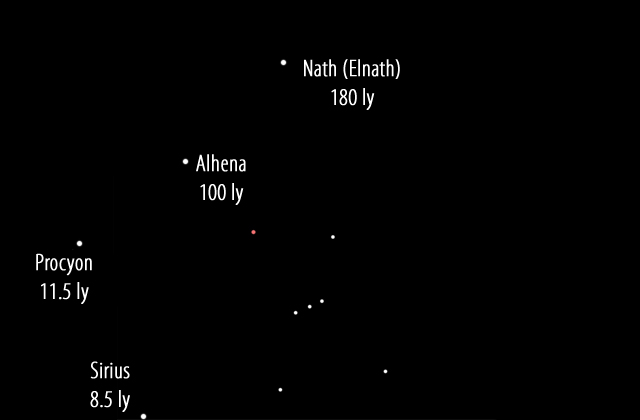 so those are the names of these stars. So what do we see here. Procyon. Procyon means in front of the dog, afore the dog. Because straight under Procyon there is is star called Sirius. Both stars are very bright. And Sirius was often called the Dog-star. Actually Sirius means bright the name comes from ancient Greece: Σείριος Seirios (“glowing” or “scorcher”). Sirius is part of the constellation Greater Dog or in latin: Canis major.
so those are the names of these stars. So what do we see here. Procyon. Procyon means in front of the dog, afore the dog. Because straight under Procyon there is is star called Sirius. Both stars are very bright. And Sirius was often called the Dog-star. Actually Sirius means bright the name comes from ancient Greece: Σείριος Seirios (“glowing” or “scorcher”). Sirius is part of the constellation Greater Dog or in latin: Canis major.

Sirius are like really many stars actually two stars orbiting each other. Often even more then two stars orbit each other. In this case you call the bigger one Sirius A and the smaller one Sirius B. So it is done A, B, C, D… . From earth you only see one combined “star”.
Sirius and Procyon are very close to earth. Sirius is 8.4 ly away and Procyon is 11.5 ly away. Of course this is an increadible distance but compared to the stars of Orion with their distances of around 700 ly Sirius and Procion hover right next to us. They are about the size of our sun. Sirius is actually twice the size of our sun and light blue. Procyon is white yellow. Procyon and Sirius are both a double star system. So the star that we see is orbited by another star which is a white dwarf. Really many stars are rotating double or even multiple star systems where more then two stars complicatedly orbit each other, but if you look into the sky they all just look like one star, because they are so close together, but they all add to the brightness of the “one star” that you see. In the rest of this article it is not mentioned if a star is a multiple star system but many of the stars are actually multi star systems. In this article always only the main star is described and if it is a multiple star system is not mentioned so you know that many of them are actually some stars together. Sirius is the brightest star in the sky, if you do not count our planets which also look like stars to us. Because then Venus is the brightest star. But venus is actually a planet of course. Venus is always the first star you see in the evening, long before all others and it is the last star you see in the morning Therefor Venus is called both the “evening star” and the “morning star”.
In the Sirius double star system one of the suns is much bigger. But stars in multiple star systems can also have both the same size. Many stars we see are actually multiple star systems. Sirius is the brightest real star in the sky because it is so close and 25 times as luminous as the sun. Which is by far not as bright as for example Rigel, Rigel is much brighter but it is just further away, so it does not seem so bright. Sirius was always an important star because it is so bright, ancient people measured the times of sowing with the position of Sirius. Alhena is about 100 or 110 ly away. It is also called Almeisan. Alhena derives from Arabic al-Han’āh which means brand (on the neck of the camel), while Almeisan derives from arabic al-Maisān which means “the shining one”. Many stars have arabic names because in the arabien world the people where among the first peoples on earth of enough culture to chart the stars scientifically. English Wikipedia states that Alhena is 3 times the size of the sun. German wikipedia says that it is 5 times the size of earth. So I can’t tell. If you are a professional astronomer you must send me a comment on this. Alhena is a star in the constellation Gemini, Twins. Procyon is in the very small constellation canis minor, little dog. And Elnath which means the horn is in the constellation of Auriga, the wagon driver and Elnath is also part of the Taurus, the Bull. And it is the horn tip of one of the two horns of the Bull. So the Bull pierces Auriga a little at Elnath we will see this later. So with these three distinct stars that form a line over Orion you can orientate quite well. And there s another interesting thing about Elnath. It lays towards the outer side of our Galaxy. You know that in Summer, in the month August we look towards the center, the middle of our Galaxy if we look up to the sky. But in Winter in the month January, February we look to the outside of our galaxy when we look up into the sky because earth turns in one year around the sun. And so looking towards Elnath means to look nearly straight in the direction that leads out of our galaxy at the outer edge that is closest to earth. This direction opposit to the galactic center is called anticenter. Before we go to these constellatons notice Aldebaran (yeah nearly like Alderan in Star Wars, there is also a place in Afrika called Tatooine). It is to the right over Orion and very bright and a little red. It springs to the eye. So there is Aldebaran. Aldeberan is a red giant sun. We had it in the size comparison image above. ad-Dabarān means the “following one” because Aldeberan follows the Pleades which we will see later. Aldebaran is the middle of Taurus. Elnath is the rearmost of the two front horn tips the horns sotart somewhere close to Aldeberan and are very long. The tip of the front horn is a star called Tien Quan(400 ly) we will see later and this is a bit low between Elnath And Alhena.. 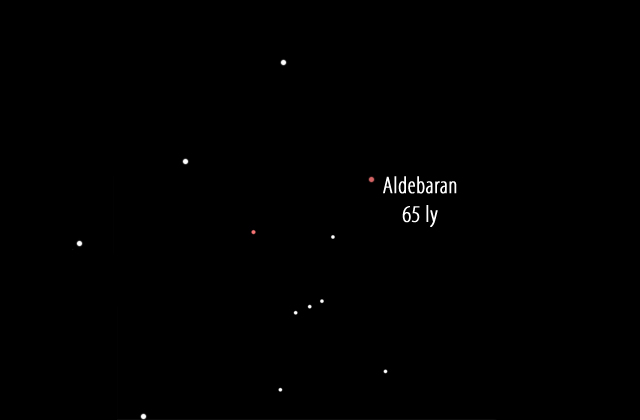
Auriga, Gemini, and Canis Minor. The names of the stars in the constellations
If you look at the line Procyon, Alhena, Elnath in the sky, you see that over this line there are two pairs of very bright stars like a roof over this line.  If you step outside and directly watch the stars these stars will appear very early and then the stars around them will appear. The same is true for the Procyon line. So what are these 2 distinct pairs of stars
If you step outside and directly watch the stars these stars will appear very early and then the stars around them will appear. The same is true for the Procyon line. So what are these 2 distinct pairs of stars 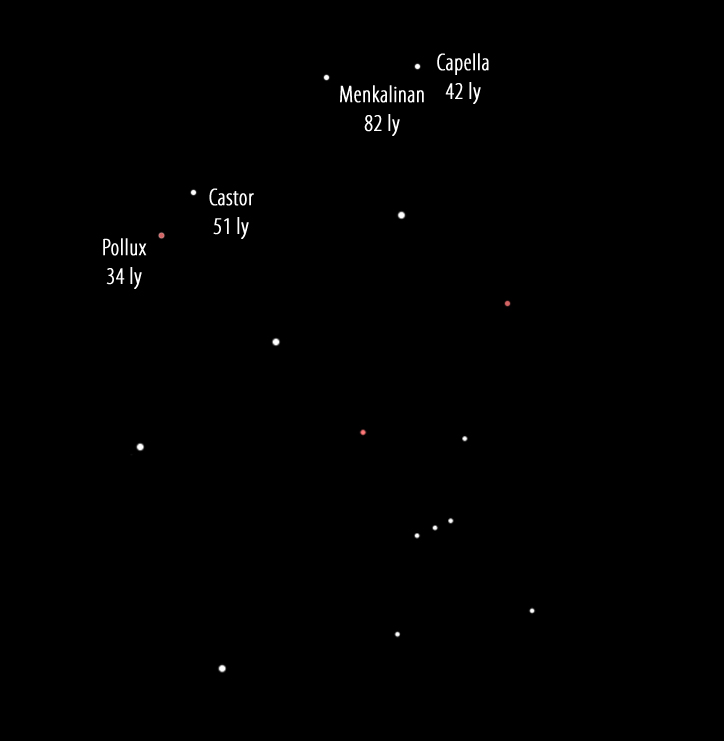 These two pairs of stars are easy to find and make for a good and easy orientation in the night sky.The stars to the left Pollux and Castor are the heads of the two people that form the Gemini, the Twins. The stars to the right, Capella and Menkalinan are the top of Auriga the wagon driver. And from the row Procyon, Alhena, Elnath, Elnath is the bottom star of Auriga, the wagon driver. Auriga looks like a poligon.
These two pairs of stars are easy to find and make for a good and easy orientation in the night sky.The stars to the left Pollux and Castor are the heads of the two people that form the Gemini, the Twins. The stars to the right, Capella and Menkalinan are the top of Auriga the wagon driver. And from the row Procyon, Alhena, Elnath, Elnath is the bottom star of Auriga, the wagon driver. Auriga looks like a poligon.  And the stars from Auriga are these
And the stars from Auriga are these 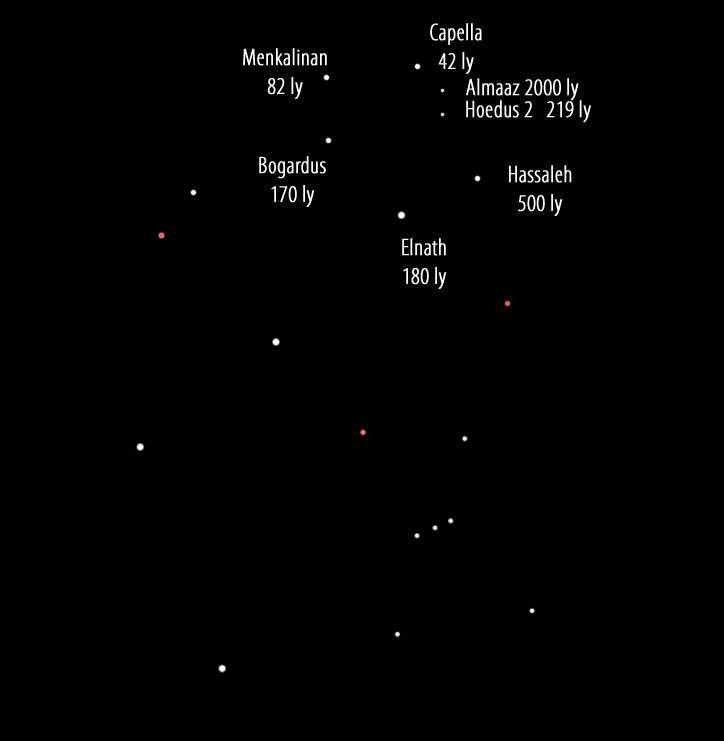 We can see that the stars in Auriga have names from different old countries. I think it was Latin, Arabic, Greek and Hindi, I think I read this on the internet somewhere. And also very interesting is Almaaz because of its distance. Almaaz is 2000 ly away. If you imagine the Milkyway Galaxy as having 10 centimeters diameter (3.9 Inches) then a tenth part is one centimeter which is about a finger seen from the side. Then one millimeter, which is the tenth of a centimeter is about 1000 ly. So Almaaz is 2 millimeters away in a ten centimeter(100 millimeter) Galaxy. What is special about this distance is that the stars we are talking about here, the big usually to be seen stars are mostly not farther away then this 2000 lightyears. There are farther away fainter stars between these bright stars that you can then see if it is really dark that seem to go up to distances between 6000 lightyears and 8000 lightyears but all these big stars that you really easily see are about up to 2000 ly away. Twins is supposed to look like two people beside each other. And if you think themas standing upright, because they can appear upside down of course, If you think them upright then Alhena is somewhat the foot area of the left person. And so above the foot there are the two heads. Those are the stars are Castor and Pollux. You can not miss these two they stand quite next to each other and are very bright. We will come to a picture later. In the northern hemisphere it is easy to memorise since we always say Castor and Pollux, while actually in the sky it is Pollux and Castor (in winter). That means from left to right as if you would read. Turn the normal arrangement and you have the stars. If you draw a line from Pollux to Alhena, from the head to the foot, then you have one person of the Gemini, Twins. And this line points to Betelgeuse. So in the image I think the two heads are combined with a line, just to understand how the constellation of Gemini should look like for better orientation. It is not easy to say how the constellations look like because probably the people of old times saw nebulea, cosmic dust clouds between the stars which are now not visible because of light pollution. So we only now see the brightest stars and people before us probably saw completely different images with much more stars and nebulas. So we have to understand about our star signs that they are probably not really visible anymore.
We can see that the stars in Auriga have names from different old countries. I think it was Latin, Arabic, Greek and Hindi, I think I read this on the internet somewhere. And also very interesting is Almaaz because of its distance. Almaaz is 2000 ly away. If you imagine the Milkyway Galaxy as having 10 centimeters diameter (3.9 Inches) then a tenth part is one centimeter which is about a finger seen from the side. Then one millimeter, which is the tenth of a centimeter is about 1000 ly. So Almaaz is 2 millimeters away in a ten centimeter(100 millimeter) Galaxy. What is special about this distance is that the stars we are talking about here, the big usually to be seen stars are mostly not farther away then this 2000 lightyears. There are farther away fainter stars between these bright stars that you can then see if it is really dark that seem to go up to distances between 6000 lightyears and 8000 lightyears but all these big stars that you really easily see are about up to 2000 ly away. Twins is supposed to look like two people beside each other. And if you think themas standing upright, because they can appear upside down of course, If you think them upright then Alhena is somewhat the foot area of the left person. And so above the foot there are the two heads. Those are the stars are Castor and Pollux. You can not miss these two they stand quite next to each other and are very bright. We will come to a picture later. In the northern hemisphere it is easy to memorise since we always say Castor and Pollux, while actually in the sky it is Pollux and Castor (in winter). That means from left to right as if you would read. Turn the normal arrangement and you have the stars. If you draw a line from Pollux to Alhena, from the head to the foot, then you have one person of the Gemini, Twins. And this line points to Betelgeuse. So in the image I think the two heads are combined with a line, just to understand how the constellation of Gemini should look like for better orientation. It is not easy to say how the constellations look like because probably the people of old times saw nebulea, cosmic dust clouds between the stars which are now not visible because of light pollution. So we only now see the brightest stars and people before us probably saw completely different images with much more stars and nebulas. So we have to understand about our star signs that they are probably not really visible anymore.  Image by Torsten Bronger. Note that the star beneath Procyon conected with a green line and with the beta is Gomeisa and it is 170 lightyears away. Those two stars are already the complete Minor Dog constellation. Only those two stars, Procyon and Beta canis minoris or Gomeisa are one complete constellation, Canis Minoris, the Minor Dog We will not name the rest of the stars in Gemini, Twins, we will move on now to the next constellation which is Leo, the Lion. If we have an overview over the sky it will always be easy to learn the rest of the stars because then we know the constellation we have to look up in the internet. It is three steps: go to wikipedia: Greek alphabet, Open new tab and go to lets say constellation gemini or twins on wikipedia. You will find the same image map as directly above. And then check the modern writing of the greek letter beside each star, like epsilon, theta, my, alpha for example. And then search wikipedia for lets say epsilon Geminorum. Or to find the stars to each constellation even better go back to the top of this article and read the first paragraph, to the end of the first paragraph you find a link to a site that shows the stars of the constellations much more detailed then wikipedia. You should really visit this, it is a great site for finding stars in constellations.
Image by Torsten Bronger. Note that the star beneath Procyon conected with a green line and with the beta is Gomeisa and it is 170 lightyears away. Those two stars are already the complete Minor Dog constellation. Only those two stars, Procyon and Beta canis minoris or Gomeisa are one complete constellation, Canis Minoris, the Minor Dog We will not name the rest of the stars in Gemini, Twins, we will move on now to the next constellation which is Leo, the Lion. If we have an overview over the sky it will always be easy to learn the rest of the stars because then we know the constellation we have to look up in the internet. It is three steps: go to wikipedia: Greek alphabet, Open new tab and go to lets say constellation gemini or twins on wikipedia. You will find the same image map as directly above. And then check the modern writing of the greek letter beside each star, like epsilon, theta, my, alpha for example. And then search wikipedia for lets say epsilon Geminorum. Or to find the stars to each constellation even better go back to the top of this article and read the first paragraph, to the end of the first paragraph you find a link to a site that shows the stars of the constellations much more detailed then wikipedia. You should really visit this, it is a great site for finding stars in constellations.
Leo the Lion constellation
If you look to the left and a bit up over Castor and Pollux. You will see this.  From the stars we have seen already it is there
From the stars we have seen already it is there  Yes this is the constellation Lion. There are these stars to the right that form a line, it is very distinct in the sky you can not miss it. If there are not to many stars visible then between Castor and Pollux and this line of stars there is a space without stars. If there are more stars visible there might be some stars between, but yet the line is distinct. to the left of this line, if you are on the northern hemisphere of course, you see a triangle of stars. This is the back and the tail of the lion. I will show the real lion outlines later, the next image is just for orientation and finding it, because it looks in the sky like on the following picture. No the triangle is not the face of the lion, we can see from old star names in this constellation. Even though it would be cute this triangle is the backside of the lion. So I think the constellation looks like this if you first search it. Try to find this in the sky.
Yes this is the constellation Lion. There are these stars to the right that form a line, it is very distinct in the sky you can not miss it. If there are not to many stars visible then between Castor and Pollux and this line of stars there is a space without stars. If there are more stars visible there might be some stars between, but yet the line is distinct. to the left of this line, if you are on the northern hemisphere of course, you see a triangle of stars. This is the back and the tail of the lion. I will show the real lion outlines later, the next image is just for orientation and finding it, because it looks in the sky like on the following picture. No the triangle is not the face of the lion, we can see from old star names in this constellation. Even though it would be cute this triangle is the backside of the lion. So I think the constellation looks like this if you first search it. Try to find this in the sky. 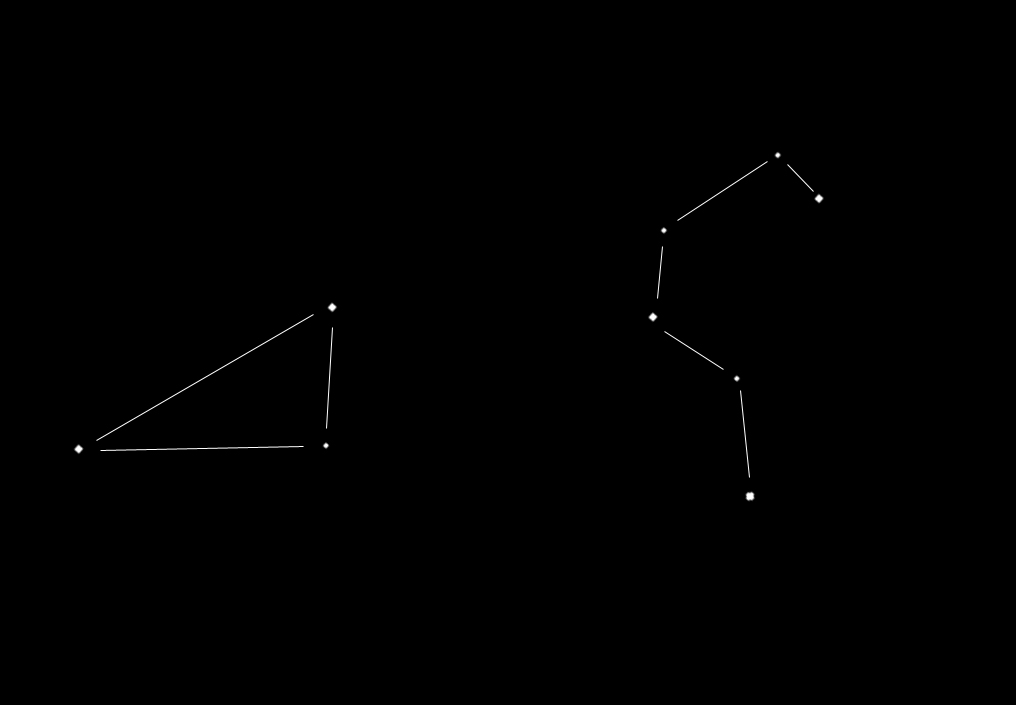 Now we look at how the stars of the constellation Leo are usually connected today. We will see later that this is probably a wrong way of connecting the stars in this constellation. But it is how it is done often at the moment. We will come to the probably better and the a bit more lion like looking connection later.
Now we look at how the stars of the constellation Leo are usually connected today. We will see later that this is probably a wrong way of connecting the stars in this constellation. But it is how it is done often at the moment. We will come to the probably better and the a bit more lion like looking connection later.  Ok, time for the names and distances of the stars in the constellation Leo.
Ok, time for the names and distances of the stars in the constellation Leo.  What is interesting here? First we have Al Jabhah with its distance of 2000 ly. Again a far away star that is 2000 ly away. It is like Almaaz we had before, if you search this text for “milkyway” you can jump to this part of the text again and read what is interesting about this distance. Al Jabhah is a giant white star a bit smaller then Rigel. It is much farer away then the other stars we see in the lion constellation. What we first notice of course is that two stars go by nearly the same name Ras Elased and then Borealis and Australis.Well Borealis is latin for north and Australis is latin for south. In early Arabia both stars seem to have had the same name: raʾs al-asad ‚Head of the lion‘ or in a western writing style Ras Al Asad. And to distinguish the both Ras Al Asad stars one was called northern, borealis and the other one southern, australis. I think I will stick to Ras Al Asad and not go for Ras Elased. Other names for the northern one, Ras Al Asad Borealis are: μ (My) Leonis, Rasalas, Alshemali. Other names for the southern one, Ras Al Asad Australis are: ε (Epsilon) Leonis, Algenubi, Asad Australis. Zosma is a yellowish Giant. Other names for Zosma are Dhur and Duhr. The close Denebola is surrounded by a disc of dust. The name comes from arabian ðanab al-asad “tail of the lion” Algieba is an about half rigel sized yellow star. It name comes from arabic “mane of the lion” Now we come to the better outline for the Leo constellation. As I said Algieba comes from the arabic word for “mane of the lion”. Adhafera ( or Aldhafera, Adhafara) comes from arabic al-ðafīrah “the braid/curl”. So these two stars have names about the curly lions hair. Al Jabhah comes from the arabic word for “the forehead”. So Al Jabhah should by the name actually be part of the head but I think that is not so. And Chertan (θ (Theta) Leonis) comes from Arabian ḫarātān “two little ribs” and other names for Chertan over time where Chort („little rib“), Coxa („hip“). So if Chertan was called “little rib” or “hip” then the stars for the feet must be even below Chertan. So there must be some foot stars to this lion. So I have taken the starmap linked to at the beginning and put it to show more stars that are usually seen in the sky and looked for a lion image. And I really found a fascinating lion image around the constellation Leo, lion. You really should follow that link and at least scroll the article right to the end to see this lion image. if you are interested in stars you will love this. In England close to the city Uffington there is an ancient giant drawing on the ground a little bit like the Nazca lines. The giant drawing looks a little bit like a horse or a fantasy animal. It is called the Uffington White Horse and is probably 2800 years old.
What is interesting here? First we have Al Jabhah with its distance of 2000 ly. Again a far away star that is 2000 ly away. It is like Almaaz we had before, if you search this text for “milkyway” you can jump to this part of the text again and read what is interesting about this distance. Al Jabhah is a giant white star a bit smaller then Rigel. It is much farer away then the other stars we see in the lion constellation. What we first notice of course is that two stars go by nearly the same name Ras Elased and then Borealis and Australis.Well Borealis is latin for north and Australis is latin for south. In early Arabia both stars seem to have had the same name: raʾs al-asad ‚Head of the lion‘ or in a western writing style Ras Al Asad. And to distinguish the both Ras Al Asad stars one was called northern, borealis and the other one southern, australis. I think I will stick to Ras Al Asad and not go for Ras Elased. Other names for the northern one, Ras Al Asad Borealis are: μ (My) Leonis, Rasalas, Alshemali. Other names for the southern one, Ras Al Asad Australis are: ε (Epsilon) Leonis, Algenubi, Asad Australis. Zosma is a yellowish Giant. Other names for Zosma are Dhur and Duhr. The close Denebola is surrounded by a disc of dust. The name comes from arabian ðanab al-asad “tail of the lion” Algieba is an about half rigel sized yellow star. It name comes from arabic “mane of the lion” Now we come to the better outline for the Leo constellation. As I said Algieba comes from the arabic word for “mane of the lion”. Adhafera ( or Aldhafera, Adhafara) comes from arabic al-ðafīrah “the braid/curl”. So these two stars have names about the curly lions hair. Al Jabhah comes from the arabic word for “the forehead”. So Al Jabhah should by the name actually be part of the head but I think that is not so. And Chertan (θ (Theta) Leonis) comes from Arabian ḫarātān “two little ribs” and other names for Chertan over time where Chort („little rib“), Coxa („hip“). So if Chertan was called “little rib” or “hip” then the stars for the feet must be even below Chertan. So there must be some foot stars to this lion. So I have taken the starmap linked to at the beginning and put it to show more stars that are usually seen in the sky and looked for a lion image. And I really found a fascinating lion image around the constellation Leo, lion. You really should follow that link and at least scroll the article right to the end to see this lion image. if you are interested in stars you will love this. In England close to the city Uffington there is an ancient giant drawing on the ground a little bit like the Nazca lines. The giant drawing looks a little bit like a horse or a fantasy animal. It is called the Uffington White Horse and is probably 2800 years old.
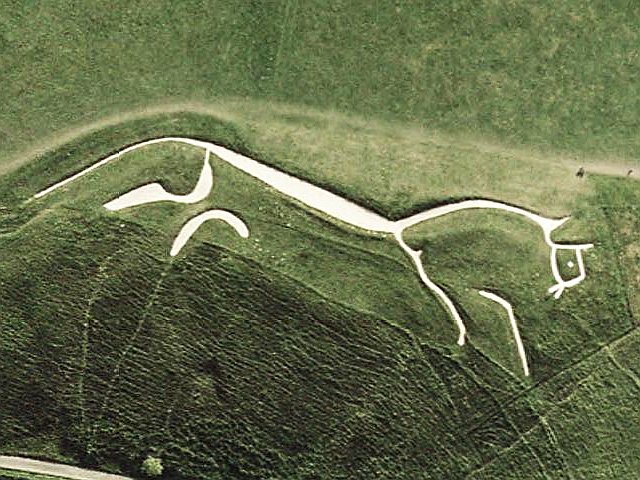 And so the whole thing looks from the air. Now J. Krem found out that the Uffington White Horse fits perfectly into the stars of the lion constellation if you use more stars from around the constellation.
And so the whole thing looks from the air. Now J. Krem found out that the Uffington White Horse fits perfectly into the stars of the lion constellation if you use more stars from around the constellation.
The Taurus Constellation
To the right of Orion , or to the left depending on where you are, there is the constellation Taurus, the Bull. Taurus and Auriga, the wagon driver, share one Star. Elnath “the horn” is a star that counts to be in both constellations. so Taurus the bull pierces the hexagon of Auriga with the tip of one horn.  The Bull seems very much to be a constellation that ancient civilisations already used to call a bull. In south western france there is a cave in which prehistoric people lived and they painted the cave paintings of Lascaux 17,300 years ago.
The Bull seems very much to be a constellation that ancient civilisations already used to call a bull. In south western france there is a cave in which prehistoric people lived and they painted the cave paintings of Lascaux 17,300 years ago.  Note how where the bigger black point at the eye of the bull is there is the brightest star of the constellation. And how quite exactly the horn stars fit. And of course the points in the face that make up a V-shape and look like the stars of the constellation. And also note that were the group of points behind the bull is, that is where in the sky the pleades are wich are the white points from the starmap. The Pleiades are important. The Pleades are a group of close stars in the sky. They where watched and specially noted by older civilisations. Probably for measuring times for sawing the seeds. Have you heard of the nebra sky disk.
Note how where the bigger black point at the eye of the bull is there is the brightest star of the constellation. And how quite exactly the horn stars fit. And of course the points in the face that make up a V-shape and look like the stars of the constellation. And also note that were the group of points behind the bull is, that is where in the sky the pleades are wich are the white points from the starmap. The Pleiades are important. The Pleades are a group of close stars in the sky. They where watched and specially noted by older civilisations. Probably for measuring times for sawing the seeds. Have you heard of the nebra sky disk.
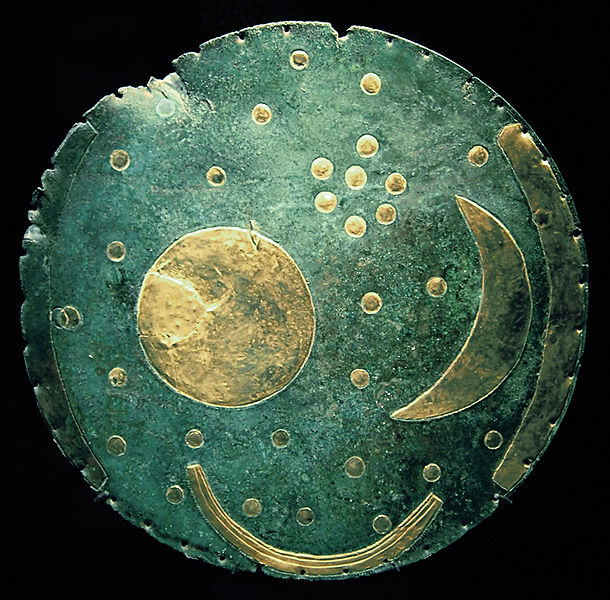
An ancient (4000 years old) copper (now with green patina) disc for ritual, religious ond astronomical purpuses. The ring of stars at the top right are the Pleiades. Image by D. Bachman.
The Pleiades are stars noted by old cultures because some complex measurement of time can be done with comparing the sun or the moon going over the sky to the position of the Pleiades. I don’t know exactly but watching the Pleiades has a long tradition. This is how the constellation Taurus. the bull looks like. Note the bright red star, that is now Aldebaran. Aldebaran is a red giant star. Behind the bull you see the Pleiades. The top right Horn is Elnath (from arab. “The Horn”), this is the star that is also in the constellation Auriga.  And now we come to the names of the stars in Taurus, the bull.
And now we come to the names of the stars in Taurus, the bull.  These are the stars in Taurus. Aldeberan we had before, it is a giant red sun. Compared to the sun it is gigantic. But then there are the massively bigger stars Antares and Betelgeuse. Yshakaron can also be called Ushakaron which is Akkadian for “Exacter of Justice and Retribution” or “The Avenger” or “The Vindicator”. Alcyone is a star in the star cluster Pleiades. Alcione is a girl from greek mythology and the Pleades where actually a group of people from greek mythology and so the stars of the Pleades are named after these fictional people. Alcyone is 400 lightyears away. The Hyades are also a star cluster, a group of stars like the Pleades. And from the Hyades group we see the brightest stars and those are the stars of the V-shape of the bull. All stars in the V-shape, but not the big bright Aldebaran. Aldebaran is closer to us then the Hyades star cluster. Of course Taurus the bull consists of much more stars and we only see the very brightest ones. And of the many stars that are actually there but never seen with the naked eye some few more can be seen sometimes.They seem to form a bull, but for the question how the constellations where thought of in the past you really have to see the article “Real images in the constelations” on this site. Here are the stars around Taurus constellation. I don’t recommend to learn these. I recommend going on to the next constellation and then when you learned them all come back here and learn them if you still want more. I just show them that we have seen it once. So I would just look at the dust cloud of taurus in the next two images and then I would go on to Perseus constellation.
These are the stars in Taurus. Aldeberan we had before, it is a giant red sun. Compared to the sun it is gigantic. But then there are the massively bigger stars Antares and Betelgeuse. Yshakaron can also be called Ushakaron which is Akkadian for “Exacter of Justice and Retribution” or “The Avenger” or “The Vindicator”. Alcyone is a star in the star cluster Pleiades. Alcione is a girl from greek mythology and the Pleades where actually a group of people from greek mythology and so the stars of the Pleades are named after these fictional people. Alcyone is 400 lightyears away. The Hyades are also a star cluster, a group of stars like the Pleades. And from the Hyades group we see the brightest stars and those are the stars of the V-shape of the bull. All stars in the V-shape, but not the big bright Aldebaran. Aldebaran is closer to us then the Hyades star cluster. Of course Taurus the bull consists of much more stars and we only see the very brightest ones. And of the many stars that are actually there but never seen with the naked eye some few more can be seen sometimes.They seem to form a bull, but for the question how the constellations where thought of in the past you really have to see the article “Real images in the constelations” on this site. Here are the stars around Taurus constellation. I don’t recommend to learn these. I recommend going on to the next constellation and then when you learned them all come back here and learn them if you still want more. I just show them that we have seen it once. So I would just look at the dust cloud of taurus in the next two images and then I would go on to Perseus constellation.  So what are the interesting facts about these stars. The star Tau Tauri or δ Tauri (δ = Tau) is a very young star. So around Tau Tauri there are still big dust clouds that form a disc because of the rotation. It is thought that most young stars first have a dust disc and later the dust disc will build into planet. From the example of Tau Tauri all stars that look like this are called T Tauri stars. Here would be a link to Wikipedia for T Tauri stars.
So what are the interesting facts about these stars. The star Tau Tauri or δ Tauri (δ = Tau) is a very young star. So around Tau Tauri there are still big dust clouds that form a disc because of the rotation. It is thought that most young stars first have a dust disc and later the dust disc will build into planet. From the example of Tau Tauri all stars that look like this are called T Tauri stars. Here would be a link to Wikipedia for T Tauri stars.

A “T Tauri” star is thought to look something like this. Of course we can not look far enough to see this.
But here is a real photographic image of XZ Tauri lower middle left in red color(double or triple system 450 ly) and HL Tauri upper middle right in blue color(450 ly age less then 100.000 years). Both are “T Tauri type stars” So you can see dust clouds around such stars. The whole dust cloud is called Taurus Molecular Cloud. Both these stars can not be seen with the naked eye.
Other stars in taurus constellation: Theta Tauri is a double star system, but the two stars that turn around each other are ten lightyears apart. That is so far that with sharp eyes you can see both stars of this double star system very close to each other.. Xi Tauri is a quadruple (4) star system. Two stars orbit each other in 7.15 days and those two orbit the third every 145 days and the fourth star orbits all three inner stars in about 50 years of time. But from our distance it all looks like one star. since these four stars sometimes cover each other the brightness of this one “star” that we see can change a little. This is called a variable star. We will come to the most interesting changing star Algol later. Lambda Tauri was once called Sadr al Tauri and this was translated into latin as Pectus Tauri and this means “the bull chest” so we get an idea of how the romans saw the bull or the people right before them saw the bull. Lambda Tauri is also an eclipling binary star. Nu Tauri today is very dim and only the 468th brightest star in the night sky. But Nu Tauri moves just a little faster than the sun as they both keep circling around the center of the galaxy so in 4.9 million years Nu Tauri will have come very close to our sun and will then be at a distance of 14.2 lightyears and will be very bright then with a apparent magnitude of -0.66. Today it is very dim and only the 468th brightest star in the night sky.
Perseus constellation
Now the star names of Perseus
Now what are the interesting facts about the Perseus stars. One of the most interesting stars here seems to be Algol. In Perseus there are three variable stars of which the variable type of Algol seems to be the most interesting. but first lets look at the other stars.
Gorgonea Tertia also called Rho Persei is a semiregular variable star of the μ Cephei type. Which means that it changes its brightness.
Menkib is a white-blue supergiant. Some people call Xi Persei Menkib. And some call Menkib Atik.
Mirfak is also a white-blue supergiant.
Sidenote: Atik in the fictional show Futurama is home to the Omicronians and their despotic ruler Lrrr.
Delta persei is a giant star. But it is not just big. Small stars towards the end of their life grow big. And that is the case with Delta Persei. It is a small star that has now become big.
Epsilon Persei is a “beta cephei variable” star . That means its brighness changes but because of other reasons then Gorgonia Tertia.
Algol is a very special star. It gives the name for a special group of stars called “Algol variable” star. So Algol also changes its brightness but in another way then the two other just named stars. Algol is a double star system. So two stars rotate around each other. And the special thing is that these two stars rotate in our view plane. So we are looking from the side at the circle of rotation. That makes it that at some point the fainter one of those stars passes in front of the brighter one and we do not see the brighter one then for a about half an hour. This is called an “eclipse”. And during these complete two hours of the one star being in front of the other star what we see as one star Algol is less bright. And this can be obseved with the naked eye if you know the right time to look. The two stars orbit each other roughly every three days. But you can not always see this eclipse every three days because at some days it happens during the day time when you do not see stars at all. So you have to wait until the two hour eclipse happens during the night time. But with a period of about 3 days this happens quite often. So if during the next nighttime eclipse there are no clouds you can see it. Because of this strange sudden loss of brightness Algol was thought of as being a demonic star. Today luckily we do not believe in demons anymore, so Algol is just spectacular for its star eclipse.
So now when is the next eclipse of Algol to be seen?
This internetsite that is linked to below is a calculater for eclipsing stars. Go there and find the button for Algol. Then it gives you a list with the next times for Algos eclipses in “universal time” which is a time that is not bound to the country where you are in. And then find out how much time difference is between your time and the universal time. It gives you also the time in your time as written at the bottom of the page, but I recommend to check about this. And then look which of the upcoming eclipses is during the night time. The time given is the time of the middle of the two hour eclips so the eclipse starts one hour before the given time and ends one hour after the given time. As I said calculate from this the real time of the event for your country and maybe summer or winter time if you have “daylight saving”. And then hope that there will be no clouds during the next eclipse.
Algol. Eclipsing stars: times, dates
Also Gamma Persei is an eclipsing binary system but it eclipses only every 14.6 years. But then one eclipse lasts 2 weeks.
Learning the stars names in Summer. First finding the constellations
Learning the names of the stars in summer we will start of from the Big Dipper or Ursa Majoris (the big (female) bear) If you want to find the Big Dipper (which is also visible in winter) in connection to the winter stars that we have seen then it is over the Lion constellation if you think of Orion constellation to be to the lower right of the Lion and then look above the lion for the Big Dipper.  I think everyone of you will be able to find the Big Dipper in the summer night sky. In midsummer it is quite straight above. It is usually the constellation everybody knows to find in the sky. So if you can find it go outside and look quite straight up and see if you can find it. If you have never seen the Big Dipper (Ursa Major or Great Bear, actually Ursa Major means “larger she-bear”) and do not know how to find it then step outside and look into the sky quite straight above somwhere around the middle of the sky and see if you can find the form from the above picture. If you still can’t find it ask somebody for usually most people will know how to find this one constellation. It is really the most prominent. That was just for having an orientation. We will look at the stars of the Big Dipper later. First we will start to see the stars of summer with the summer triangle. In the middle of summer and in the middle of the night there is a big triangle of 3 very bright stars slightly in the south and very much straight above. So go find the big dipper and then look at the image below to see where the summer triangle should be at the moment according to the big dipper. Then go inside into the lit room again and then step outside again and look at the summer triangle because the stars of that big triangle are so bright that they are the first ones to appear when you step outside from a bright room and directly look into the sky. try to find a very big triangle of stars.
I think everyone of you will be able to find the Big Dipper in the summer night sky. In midsummer it is quite straight above. It is usually the constellation everybody knows to find in the sky. So if you can find it go outside and look quite straight up and see if you can find it. If you have never seen the Big Dipper (Ursa Major or Great Bear, actually Ursa Major means “larger she-bear”) and do not know how to find it then step outside and look into the sky quite straight above somwhere around the middle of the sky and see if you can find the form from the above picture. If you still can’t find it ask somebody for usually most people will know how to find this one constellation. It is really the most prominent. That was just for having an orientation. We will look at the stars of the Big Dipper later. First we will start to see the stars of summer with the summer triangle. In the middle of summer and in the middle of the night there is a big triangle of 3 very bright stars slightly in the south and very much straight above. So go find the big dipper and then look at the image below to see where the summer triangle should be at the moment according to the big dipper. Then go inside into the lit room again and then step outside again and look at the summer triangle because the stars of that big triangle are so bright that they are the first ones to appear when you step outside from a bright room and directly look into the sky. try to find a very big triangle of stars.  This is the “summer trangle”.This will give us a great orientation in the southern midsummer sky. Before we look at the stars of the summer triangle lets have a look at one more star that I also put in the picture with the summer triangle. It is the one to the lower right. This is Arcurus. So the point for orientating here is: if you in the middle of a summer night look up and towards the south then you will see the summer triangle a bit to the left and on the other side to the right you see this one really bright star of a slightly reddish color. So you see very clearly a bit to the left the summer triangle and a bit more to the right Arcturus. Arcturus is really very bright it is the third brightest star of all. keep in mind that the stars move during the night and in this case if you are facing the south they turn roughly around a point straight upwards and from left to right. that means the later it is in the night the more these named stars go coming from left and going to the right. So summer triangle and Arcturus both go into the same direction during each night.as all other stars(because the earth is turning under them). Now before we move on we will first look at the position of the constellation small dipper. The small dipper can easily be found going of from the big dipper.
This is the “summer trangle”.This will give us a great orientation in the southern midsummer sky. Before we look at the stars of the summer triangle lets have a look at one more star that I also put in the picture with the summer triangle. It is the one to the lower right. This is Arcurus. So the point for orientating here is: if you in the middle of a summer night look up and towards the south then you will see the summer triangle a bit to the left and on the other side to the right you see this one really bright star of a slightly reddish color. So you see very clearly a bit to the left the summer triangle and a bit more to the right Arcturus. Arcturus is really very bright it is the third brightest star of all. keep in mind that the stars move during the night and in this case if you are facing the south they turn roughly around a point straight upwards and from left to right. that means the later it is in the night the more these named stars go coming from left and going to the right. So summer triangle and Arcturus both go into the same direction during each night.as all other stars(because the earth is turning under them). Now before we move on we will first look at the position of the constellation small dipper. The small dipper can easily be found going of from the big dipper.

Note how the small dipper is positioned towards the big dipper. It is the other way around and pointing downwards towards the big dipper. While both are close to each other.
Go out and try to find the small dipper constellation going out from the big dipper. Now before we go on just a little notion about the big dipper. The name big dipper referes to these really big soup spoons to put soup into the plates. But in ancient times the constellation was called Ursa major. That means big female bear. The big dipper stars are just the brightest stars of the Ursa major “big bear” constellation. So the constellation big bear which is the same as the big dipper actually looks like this. 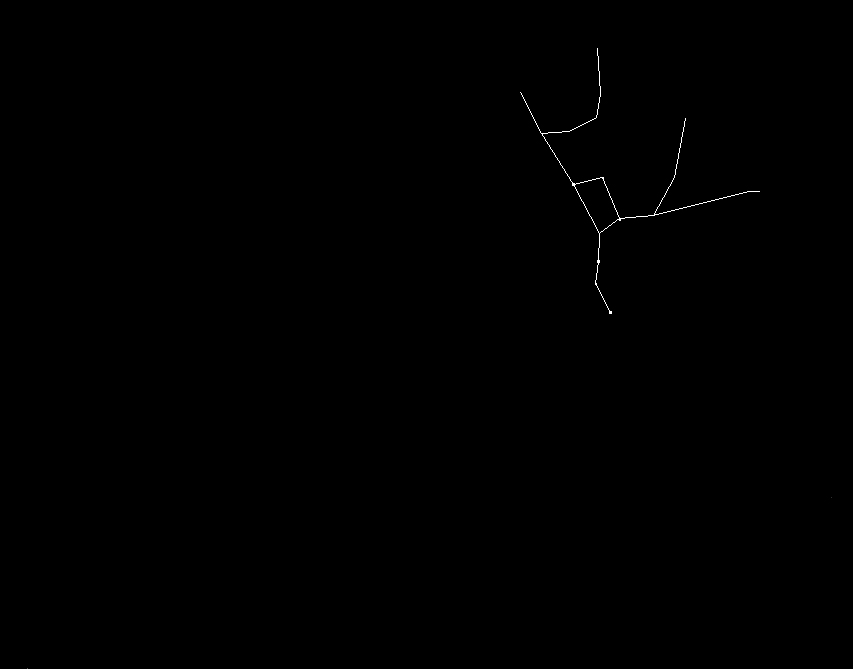 notice that there are just some sidearms to the dipper to complete the bear. We will come to this later when we look at the stars of the big dipper. But lets first get more overview over the sky.
notice that there are just some sidearms to the dipper to complete the bear. We will come to this later when we look at the stars of the big dipper. But lets first get more overview over the sky.  Now right between the big and the small dipper there is the “tail” of a constellation called “draco” that is the latin word for dragon. Search it between the big and the small dipper and then see how it winds arount the small dipper and then winds the other way up to its “head”. Going out from small and big dipper this constellation is easy to find. Now we get back the summer triangle and arcturus into this picture.
Now right between the big and the small dipper there is the “tail” of a constellation called “draco” that is the latin word for dragon. Search it between the big and the small dipper and then see how it winds arount the small dipper and then winds the other way up to its “head”. Going out from small and big dipper this constellation is easy to find. Now we get back the summer triangle and arcturus into this picture.  So you see that the three stars of the summer triangle: Deneb, Vega and Altair are in three different constellations. Deneb is in the “swan”, Vega is in the “lyra” and Altair is in the “eagle”. Arcturus is in even another constellation called “boötes” the “herdsman”. The two points over the o are not a german letter. The points say that each o is spoken seperately: bo-otes. So we see four constellations here:
So you see that the three stars of the summer triangle: Deneb, Vega and Altair are in three different constellations. Deneb is in the “swan”, Vega is in the “lyra” and Altair is in the “eagle”. Arcturus is in even another constellation called “boötes” the “herdsman”. The two points over the o are not a german letter. The points say that each o is spoken seperately: bo-otes. So we see four constellations here:
- Swan (Deneb is in the swan)
- Lyra (Vega is in the lyra)
- Eagle (altair is in the eagle)
- Boötes (Arcturus is in boötes)
All these constellations are easyly recognizable in the night sky. Try to find them orientating at the Summer triangle and at the very bright star Arcturus to the right of the summer triangle. Check the constellation boötes at its characteristic form and if it comes somewhat close to the handle of the big dipper. And make clear for you which star of the summer triangle is which by noticing that Vega is closest to Arcturus and Altair is the one close to the horizon so to say the lowest star of the triangle (if you are on the northern hemisphere on the southern hemisphere this triangle will appear upside down with Altair on top). If you see the constellations around these stars you will notice that Deneb’s swan looks like a cross and the Lyra is quite small and the eagle is quite triangular. So you will know which star is which in the summer triangle.
Explanation Deneb, Vega, Arcturus, Altair. ————————————-
Now nearly everything between the triangle and boötes is the constellation hercules.
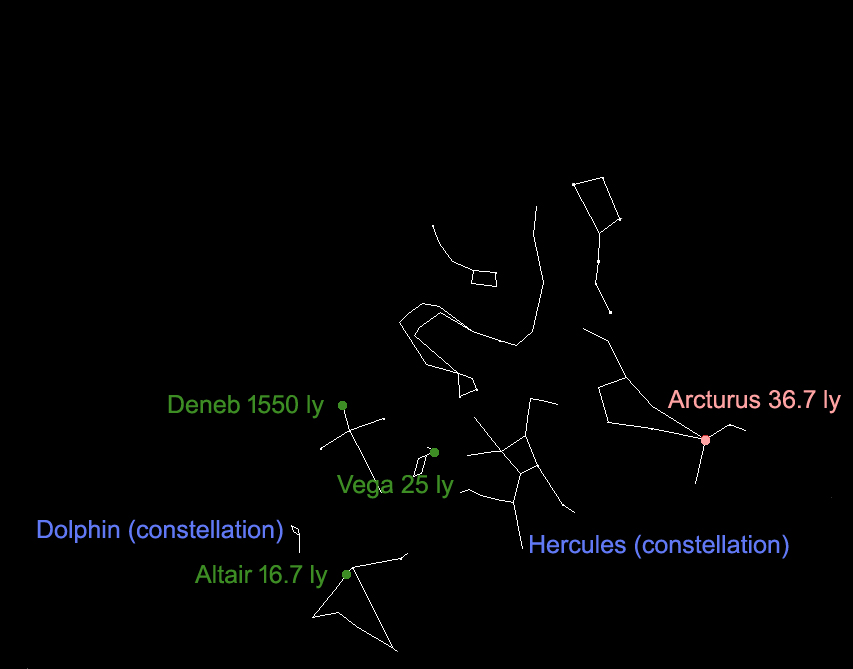 And because it is so cute I also show the constellation dolphin here. A very small constellation close to the eagle. It is on that side of the triangle where Deneb is. It is difficult to see hercules in this form because many stars of hercules are not very bright. But one can clearly see the characteristic form of boötes with especially the bright star Arcturus and of course one can easily see Vega in the summer triangle. So it is easy to at least understand that everything in between boötes and Vega belongs somehow to the constellation hercules. Try to find it at least vaguely. And if you want search for the dolphin. If you know where the dolphin is it is easy to find it. The next constellations that we will find are Cepheus” and Cassiopeia. Perseus we already had with the winter stars. Many constellations can be seen in winter and in summer such as this Perseus but also the Cassiopeia. So now we focus on Cepheus and Cassiopeia.
And because it is so cute I also show the constellation dolphin here. A very small constellation close to the eagle. It is on that side of the triangle where Deneb is. It is difficult to see hercules in this form because many stars of hercules are not very bright. But one can clearly see the characteristic form of boötes with especially the bright star Arcturus and of course one can easily see Vega in the summer triangle. So it is easy to at least understand that everything in between boötes and Vega belongs somehow to the constellation hercules. Try to find it at least vaguely. And if you want search for the dolphin. If you know where the dolphin is it is easy to find it. The next constellations that we will find are Cepheus” and Cassiopeia. Perseus we already had with the winter stars. Many constellations can be seen in winter and in summer such as this Perseus but also the Cassiopeia. So now we focus on Cepheus and Cassiopeia.  Close to the first swing of “Draco” the dragon there is “Cepheus” which looks very much like a little house. But actually Cepheus was a mythological man in greece fictional stories and he was king of Aethiopia. And his wife was called Cassiopeia and also her constellation is next to Cepheus. Cassiopeia is one of the most well known constellations in the night sky because is is so easy to recognize. It looks like a “W” or if you so want like an “M” So it is sometimes called the “sky-W” or “sky-M”. In many northern locatons it can be seen year-round. Try to find those two constellations. If you look on the given side of the Draco and the small dipper you should easily recognize the “house-shape”. And then you will also easily see Cassiopeia the “sky-W” Summer triangle.Big dipper, small dipper, draco Bootes, Arcturus, Swan, Hercules, Eagle, Lyra
Close to the first swing of “Draco” the dragon there is “Cepheus” which looks very much like a little house. But actually Cepheus was a mythological man in greece fictional stories and he was king of Aethiopia. And his wife was called Cassiopeia and also her constellation is next to Cepheus. Cassiopeia is one of the most well known constellations in the night sky because is is so easy to recognize. It looks like a “W” or if you so want like an “M” So it is sometimes called the “sky-W” or “sky-M”. In many northern locatons it can be seen year-round. Try to find those two constellations. If you look on the given side of the Draco and the small dipper you should easily recognize the “house-shape”. And then you will also easily see Cassiopeia the “sky-W” Summer triangle.Big dipper, small dipper, draco Bootes, Arcturus, Swan, Hercules, Eagle, Lyra
And now lets put in the rest of the constellations. Those are most of the constellations that you see in the Summer night sky if you look above. So I put in a lot of constellations now. But first we will talk of Pegasus constellation and then later we will look at the others. So first let us find Pegasus / Andromeda.
This is to the east the next constellation. Pegasus is also Andromeda. Those are two different names for the same constellation. Exactly actually only a few stars of the Pegasus form the constellation Andromeda. Note how the Pegasus is beside Cassiopeia, Cepheus, Swan and Eagle. That means when you look at the sky the Pegasus constellation is so big that ist does not look like one constellation because the stars of Pegasus go from just above the horizon to right above your head. So if you go out from the swan to the Pegasus then you see the part of the Pegasus which is recognizable as a constellation because these stars are bright and close together. I am talking about the middle right part of the Pegasus which probably are two of the legs of Pegasus. Pegasus is a horse with wings again from ancient greek fictional stories. So the whole constellation must resemble a horse somehow. And I think the two pair of double lines that go of from the big square shape should be the legs. And the big square shape should be the body. So if you go out from the swan you can find these legs and the big square shape. And the rest of this constellation goes then quite far over the sky. In summer when Deneb and the Summer Triangleare far enough gone from east to west so that there is enough space for Pegasus then you will find it. Try to go to Deneb in the Swan, by the way Deneb marks the tail of the Swan, and then go from Deneb to the east because at this point the first Pegasus stars are very close by. I think those are the front hoofs or back hoofs(I don’t know). And remember Pegasus stretches from the northeastern part of the sky to the southeastern part.
And then also in the image there are some other constellation that we have not named yet. Those are constellations that you don’t notice to much because they have only faint stars. It is like some middle areas between the big constellations. but these fainter stars are also in constellations. So here are the names of these faint constellations that are somewhat between the brighter constellations.
If you know that they are there and where to look for them you will easily find these fainter constellations if you look at the sky in a starry night. But they are by their lack of brightness clearly not the main constellations.
The Stars in the constellation Cassiopea
Now after we got a solid overview of where the constellations are and how we can find their positions lets get back to learning some star names. First lets look at the Casseiopeia. As I said the Cassiopeia is one of the very well known constellations. Before we look at the stars of this constellation we first want to look at its location once more between its neighbors.
So we can see that the Cassiopeia neighbors Pegasus because as I said Pegasus is a constellation that spreads over a very large area in the sky. So large that Pegasus does not look like one constellation to much. So we can see that Casseiopea and Pegasus touch each other. And what else do we see in this overview image. We see that Cassiopeia is close to Perseus and Perseus is close to Auriga and the Bull. And Auriga and the Bull are themselves close to Orion as we saw with the winter stars. So In a way here we see here where the summer and winter stars meet. In Middle Europe the Cassiopea can be seen in winter and in summer.
The cassiopeia can be puzzeling if you want to name the Stars it consists of because you never know which side of the “W” is up and which side down. The form of this constellation makes it look the same from both sides. So look at the above image and look at where Cepheus and Perseus are located and note that in the following image the cassiopea is turned just the same way as in the image before. So you have to orientate with this and learn the names of the stars in cassiopeia together with learning in what direction those stars are in regard to Cepeus and Perseus in order to be able to see what side of the casseopeia has which stars. So lets say the Casseopeia looks like an “E” that opens up towards Cepheus. And this “E” is closed towards Perseus. With this we have an up-point of the cassiopeia. Just get aware of this position of the Cassiopeia and learn the names of the stars in this constellation according to these two neighboring constellations. Otherwise you will never know how the Casseopeia is turned and which is the up-side and which is the down-side. So we say if the Cassiopeia is an “E” it is opened towards Cepheus. Actuall you only need to make clear for yourself that if you see Cassiopeia as a “W” that there is a left side of this “W” and a right side of this “W” and you have to learn the star names according to their side in the “W”.
Now lets see the stars in this constellation. You will see that there are two stars that are not part of the “W” but which are also in the constellation Casseopeia. Thise stars are a bit fainter but in a starry night they are clearly to be seen.
Sigma Cassiopeiae is a double star of which the distance is not known. measurings of the distance range from 600 to 5000 ly!. So I took this one measuring saying 1520 ly that sounds about reasonable given the size of the star and its brightness. But know that this number 1520 ly could be fairly incorrect. Future measurings will give us a better distance of this star.
Tsih is a Blue giant (14 times the size of the sun). It is also called Cih or Gamma Cassiopea. Tsih is chineese and means whip. Tsih is a star that can suddely change its brightness. Look here for a wikipedia enty on this phenomenon.
Shedir (42 times sun size) is a dark yellow giant. The name Shedir (also Schedir, Schedar) comes from the arabian صدر = “sadr” which means breast. We had this in the star name “Sadr al Tauri”: “Breast of the Bull”. So Shedir was also once called “Sadr”
Caph (3 times sun size) is a variable delta-scuti type star so its brighness changes a little going brighter and less bright over the course of 2.5 hours. The giant star rotates very fast just a bit slower then earth’s rotation. So its from is not spherical but oblate sperical. Astronomers have a system to point their telescope to certain areas in the sky and talk about where to point the telescope. It is called Siderial Time. Caph’s relation to the northern star can be used to know what Sideraeal time it is. With the position of Caph as it like every other star circles the Pole Star one can read the momentary Siderial Time similar to a clock where Caph is something like the watch hand circling the Pole Star which is then the middle of this watch. But it is a 24 hour watch and and it goes counterclockwise. But in general those two stars are a bit like a watch for this Siderial Time.
- over the northern star = midnight (of the Sidereal Time)
- western of northern star = 6 am
- below northern star = noon
- eastern of northern star = 6 pm (all in “Sidereal Time”)
Caph (Wikipedia entry) is circled by a little known companion in a period of 27 days making it a double star system.
Ruchbah is an Algol type star that eclipses every 759 days but only with a really very slight change in brightness. Other names for Ruchbah are Rukbat or Ksora from arabic Rukba=knee)
Segin is a white blue star 6 times bigger then the sun.
Achird is a double star system with the two stars orbiting each other every 480 years. The bigger one of the two stars is in size, color and mass very much alike our sun. so it can bee seen as an example how the sun would look if you would watch it from achird in about 19.5 ly distance.
Cassiopeia is a queen of ancient greek fiction. She is married to Cepheus who has a neighboring constellation. If you want to see the woman figure of Cassiopeia in this constellation. Going out from this image probably the woman is upside down and sitting on a chair. So the star Schedir is probably the breasts of this woman(The name Shedir derives from the arabian word صدر şadr which means breast) and Tsih to Segin are about the legs of this woman sitting on the chair. Ruchbar should be about the knee of this woman.
In ancient Arabia the whole “W” of the cassiopeia was called “al-Kaff al-Khadib” “the stained hand” meaning a henna coloured hand. So in another system of seeing figures in the stars Cassiopeia was only the hand of a person whos head was the Pleiades other parts where Taurus and the other hand was in Ruchbah. Because of that probably Caph comes from the arabian word for palm.
Constellation Draco the Dragon
Note that when you look into the sky the head of the dragon looks differnt then what you see on the picture above because there is a bright star of Hercules close by and so it looks like you see in the next image. The lines of the image above show how the constellation really is. So the next image shows what it actually looks like in the sky but it is actually wrong because the foremost star in the next image belongs to the constellation hercules. But you will see this form in the sky when you look up. So actually the head of the dragon is flat the way you see it in the previous image. But if you look into the the sky you will see the form given below because one of the stars of Hercules constellation seem to be also part of the Dragons head. So the form as you see it below is what you look for in the sky.
The stars of Draco:
Tyl, Aldib and Chi Draconis and Pi Draconis which is not on the image are also known as “the Goat” which is an ancient image to be seen but today is not an official constellation.
Gianfar is a red giant.
Edasich is a red giant. It is orange and 12 times bigger then the sun. Like many stars Edasich also has at least one planet circeling it called Hypatia. This was the first exoplanet discovered around a giant star. Probably Edasich also has a surrounding disk of dust.
Alrakis or Arrakis (Mu Draconis) is not on the image but it is also a star of the Draco constellation. I don’t know if the fictional planet Dune(Arrakis) is called like this because of this star but I would guess so.
Tyl is a yellow giant about ten times bigger then the sun. in China is called Kin Yu which means “goldfisch”. Many stars have different names in china. Most star names are called after arabian terms because ancient arabic people had a lot of star-science. But also the ancient chineese had a lot of star scienc but the arabian people live closer to us so thats why we have names derived from their terms while China has names derived from older chineese names. Also the chineese put the stars together in different constellations.
Etanin. Around 1725 it was proven that the eatrtha turns around the sun and not vice versa using the movememnt of the star Etanin. Etanin is the brightest star in Draco and usually as the brightest star in draco it would be called Alpha Draconis but since the history or Thuban that we will see next Ethanin is called “only” Gamma Draconis.
Thuban was the north pole star in the 4th to 2nd millennium BC that is 6000 to 4000 years ago. So here is a great graphic. You see the orange ring with the 2000 on top. That means around the year 2000 (today) the star near the 2000 on the orange ring is the north pole star. on the left on the orange ring you see a 0. That means in the year zero at this point was the position of the north pole because earth does not rotate completely stable. And a bit further to the left on this ring you see -2000 so at this time 4000 years ago or 2000 BC at this given point was the northern pole in the sky. That makes Thuban the star on the orange circle between -2000 and -4000 the north pole star of ancient egypt. And if you follow the circle into the other direction you can see that around the year 10.000 that means in 8000 years Deneb will be the north pole star. The big star at the upper point of the green lines which are the constellation Swan.

Today around the year 2000 Polaris on top is the north pole star the other stars turn around. But in times before and in times to come other stars will be the pole star because Earth does not rotate completely stable. So over the millenia the earth axis points to different stars. Image by Tauʻolunga.
Constellation Ursa Majoris, the Big Bipper.
As I said before nearly everybody knows the constellation Big Dipper. Actually this constellation is called Ursa Majoris which means the Big Female Bear.
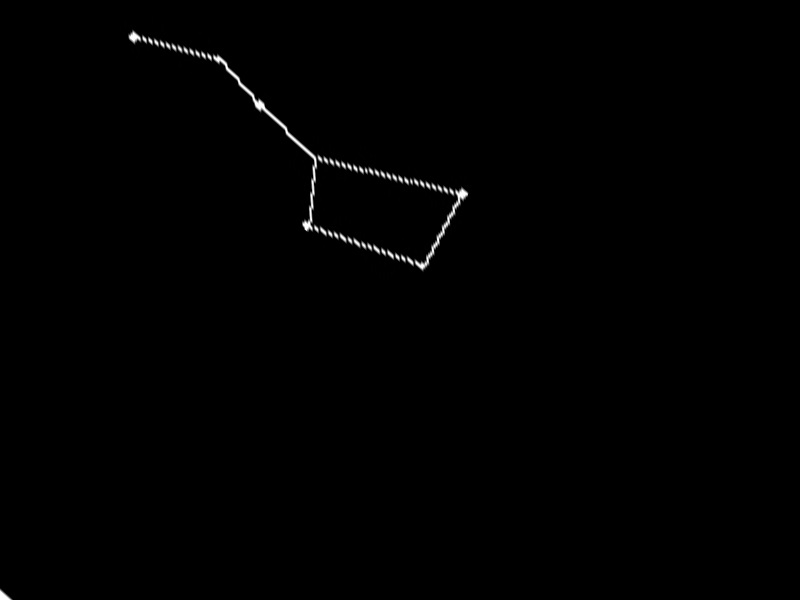
This is the constellation Big Dipper as we know it. But actually these bright stars are only a part of a bigger constellation.
And here are the stars of the Big Dipper or Ursa Majoris. I will only show the bright stars. So these are the names of the stars in the Dipper, the big soup spoon. And I do not show the names of the stars in the legs of the bear because these stars in the legs are actually very faint. So here are the names of the Big Dipper that you cleary see in the night sky.
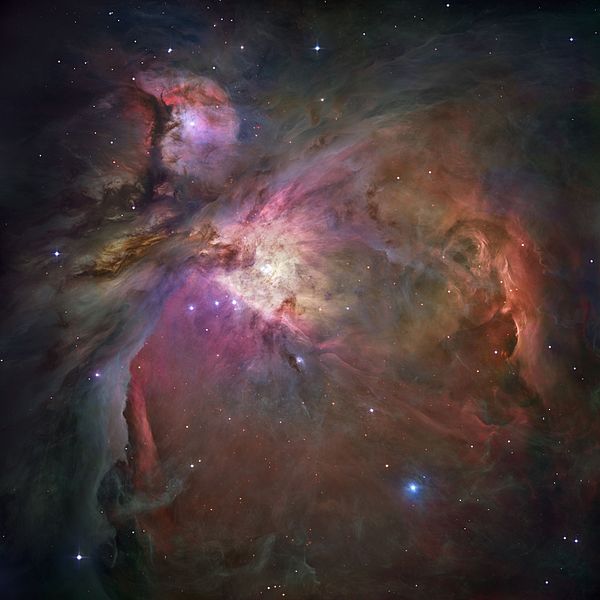
Orion nebula another molecular cloud in which stars are born. The stars then mix up the gas of the cloud and partly give its the form we see.
Despite Alkaid and Dubhe all stars are part of a group called “Ursa major moving group” They where all formed in the same molecular cloud and move with about the same speed so they say where formed together and stay together as a group. On the images you see how molecular clouds look like. Those are just example clouds not the cloud that formed the stars of ursa majoris. It it just to see ow such a cloud looks like. So most stars of ursa Majoris come from the same cloud. There we have the eagle nebula and the famous orion nebula. So many of the stars in Ursa Majoris come from a gas cloud and now they have the same speed as they circle the galactic center and are still one group. If such a group is bigger then it is called an “open cluster”. So the stars of the big dipper are believed to be a few stars that come from an “open cluster” That formed from a gas cloud 500 million years ago.
Alkaid, also called Benetnash is 3,4 times the size of our sun and of a blue-white color.
If you are further interestet in an interesting feature, Go to Wikipedia: Algol (Star) and then look at this site: eclipsing stars times dates This is a cool thing I think. But It is in the constellation Perseus and I have not yet written about Perseus. Another super interesting thing you should look at if you want to read more about stars is my article about the constellation images. There is a link. below or to the right. This is really cool. And only a short article, but really cool. There is something very fascinating. IAU and Sky & Telescope magazine (Roger Sinnott & Rick Fienberg) Image credit original Lion constellation.
So far for now. I will complete this article later. I myself still have to learn the stars of the Big dipper. so if you look above the stars we have seen here you will next go to learn Perseus, Big and small Dipper, Cassiopea and Cepheus. Use the starmap if you do not want to wait for me to complete this article which could take some time. Let the names and outlines of the constellations show in the map I named at the beginning of this article. Be shure to make Planets and Moon visible in the map. Go for a bigger map instead of 640 type in 1024. and understand that a bigger number of brightness will give you more stars and a smaller number will give you less stars according to how bright they are. The same happens with “show names of stars” If you can’t read the names because they overlap go for an even bigger map. And then look up every star on wikipedia. Have fun.

